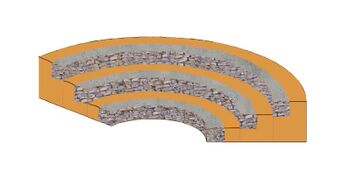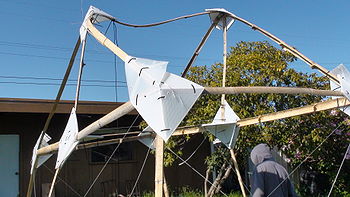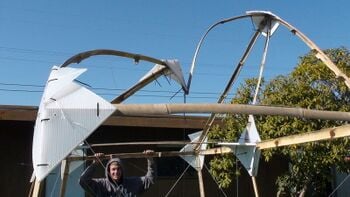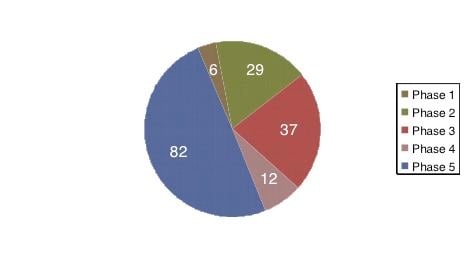Abstract
Introduction
The Builders of the Bay are a part of Humboldt State University's spring 2012 Engineering 215 course.. The Builders of the Bay consist of Cory McGill, Tyler Lowe, and Jairo Luque. The Builders of the Bay worked with Friends of the Dunes on building an amphitheater for the Humboldt Coastal Nature Center. Friends of the Dunes is a non-profit organization working to conserve the natural diversity of coastal environments through community supported education and stewardship programs [1]. The Sandy Cove Amphitheater will be used as a main center of teaching and learning at the Humboldt Coastal Nature Center. The Sandy Cove Amphitheater is constructed of stacked slabs of recycled concrete obtained from Kernen Construction. The Sandy Cove Amphitheater is a 137 degree section of a circle with three retaining walls increasing in height and length from the front to the back.

Problem Statement and Criteria
The objective of the Builders of the Bay is to design and construct an outdoor amphitheater for The Friends of the Dunes organization.
-
The schematic of the Sandy Cove Amphitheater
-
The dimensions and height of each level of the Sandy Cove Amphitheater
| Criteria | Description | Weight |
|---|---|---|
| Safety | Making the Amphitheater safe for all who use it | 10.0 |
| Durability | The lifespan of the amphitheater lasts up to five years with only minor reparations done to the structure | 9 |
| Aesthetically Pleasing | The amphitheater demonstrates professionally appealing attributes according to the clients standards | 8 |
| Capacity | 30 or more people can easily be seated and properly instructed on the amphitheater | 7 |
| Environmental Impact | Over 80% of the materials used to construct the amphitheater are recycled materials. | 4 |
| Cost | The total cost of the amphitheater does not exceed $425. | 6 |
The Sandy Cove Amphitheater Solution
The Sandy Cove Amphitheater is completely diagramed in figure 5.1-5.3. The amphitheater begins with three retaining walls constructed of stacked urbanite. The blocks of urbanite composing the three retaining walls are stacked in an offset manner to create a more structurally sound amphitheater. These walls are then backfilled with sand. The first retaining wall is 16 inches high and each level of the amphitheater increases by that measurement as you move up the amphitheater. Each retaining wall is 3 feet wide. Each wall follows the same angle of curvature, which is of 137 degrees from a single, central point that is 5 feet in front of the first wall. The first wall has an arc length of 12 feet, the second wall has an arc length of 19 feet, and the third wall has an arc length of 26 feet. The mortar used in the construction of the amphitheater is concrete.
Costs
The cost of the Sandy Cove Amphitheater was $156.22 for all the necessary materials. Friends of the dunes donated $100.00 to the total cost of the amphitheater project and therefore the cost of $56.22 was split between the three team members.
| Materials | Unit Cost ($per Unit) | Quantity | Retail cost ($) | Team cost ($) |
|---|---|---|---|---|
| 8" stakes | $.68 | 6 | $4.08 | $4.08 |
| 2' Stakes | $.92 | 7 | $6.08 | $6.08 |
| Recycled Concrete | 12.50/ton | 8 | $100.00 | Donation |
| Concrete bags | $4.25 | 15 | $63.75 | $63.75 |
| $173.91 | $73.91 |
Maintenance Costs
The amphitheater will require an occasional upkeep and additional materials as applicable. Monthly inspections of the amphitheater should be made to make sure that none of the urbanite has been removed each retaining wall. Extra urbanite is being kept on site to provide the client with the appropriate material to fix the damage.
Labor
The compilation of hours spent on each phase of the design process. Phase 1 included the problem statement as well as the black box model. Phase 2 included the Problem Analysis as well as the Literature Review. Phase 3 displayed nine different alternative solutions designed by the Builders of the Bay. During Phase 4, The Builders of the Bay sorted through the alternative solutions and designed the best fitting solution to the Humboldt Coastal Nature Center. Phase 5 detailed the chosen solution and described the building and implementation process.
Testing Results
The Builders of the Bay tested building two separate retaining walls before the final installation of the walls at the Humboldt Coastal Nature Center. The purpose of these tests was to practice the actual building of the walls and to make sure the material we were recovering from Kernen Construction would be suitable to use for stacking and building the walls.


Discussion and Next Steps
A total of 166 hours were spent on the design and completion of the Sandy Cove Amphitheater project. The Sandy Cove Amphitheater fits all specifications given to the Builders of the Bay. The amphitheater is safe due to wide steps and using sand as back fill. These are safety measures to keep the amphitheater from being to steep and to provide a soft surface instead of using solid concrete for the entire thing which could cause injury due to the hardness. Since the amphitheater is made of concrete and uses a concrete mortar, the amphitheater will be durable and will last a long time. Using recycled concrete is an aesthetically pleasing material due to the fact that it matches all other retaining walls surrounding the facility. The capacity also meets standards. Using recycled concrete as a material meets our specification of using recycled materials. Lastly using recycled concrete helped keep our cost low and well under our initial budget.
References
- ↑ . Friends of The Dunes, 2012. <http://www.friendsofthedunes.org/> (Apr. 5, 2012)


